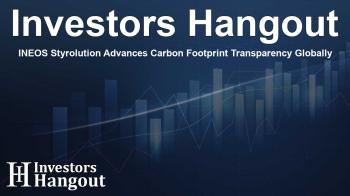INEOS Styrolution Advances Carbon Footprint Transparency Globally

INEOS Styrolution Enhances Product Sustainability Efforts
In an effort to boost transparency regarding carbon emissions, INEOS Styrolution is implementing a new Product Carbon Footprint (PCF) calculation platform across its extensive portfolio. This innovative system will automate the product carbon footprint calculations while enabling customers to monitor their scope 3.1 emissions specifically tied to INEOS Styrolution products.
Automated Carbon Footprint Calculations
The Atos PCF platform employed by INEOS Styrolution leverages a certified methodology from TÜV Rheinland, ensuring that it aligns with recognized global sustainability standards. This platform is a significant step forward in providing detailed emissions data throughout the production lifecycle, from the sourcing of raw materials, through the manufacturing phases, to the point they leave the production site.
Supporting Customer Efforts for Sustainability
This initiative not only empowers INEOS Styrolution but also its customers, enabling them to track scope 3.1 emissions for each product purchased. By doing so, customers can achieve more precise reporting and ensure compliance with climate-related regulations, enhancing transparency throughout their supply chain.
Leadership Commitment to Innovation
Steve Harrington, CEO of INEOS Styrolution, emphasized the company's commitment to sustainability, stating, "By measuring the carbon footprint of our global product portfolio, we take responsibility for our impact while enabling our customers to do the same. This tool allows us to be transparent about our emissions, while equipping our customers with the crucial data they need to target scope 3 reductions and meet their climate objectives."
Understanding the Product Carbon Footprint
The term Product Carbon Footprint (PCF) encapsulates the entire spectrum of greenhouse gas emissions linked to a product throughout its lifecycle, termed as a "cradle-to-gate" view. This comprehensive approach aids both companies and customers in assessing the climate impact of specific items and identifying strategies to mitigate emissions along the value chain.
Defining Scope 3 Emissions
Scope 3 emissions represent the indirect greenhouse gas emissions that are part of the value chain of a reporting company, such as emissions generated during the production of raw materials, logistics, the product's use, or its disposal. Scope 3.1, a vital subcategory, specifically pertains to emissions generated from procured goods and services, typically constituting the largest portion of emissions for many manufacturing entities.
INEOS Styrolution's Commitment to Quality and Sustainability
INEOS Styrolution stands as the foremost producer of high-performance styrenics, offering an extensive range that includes styrene monomer, polystyrene, ABS, and advanced styrenics. The company excels in providing customized solutions tailored to various sectors such as automotive, healthcare, electronics, household, construction, packaging, toys, and sports. With a legacy spanning over 90 years in material science and a network of 16 production sites, INEOS Styrolution merges global reach with local insights, adeptly addressing the dynamic needs of customers. Their ongoing efforts are focused on delivering safe, sustainable, and efficient products while aiding their clientele in achieving sustainability targets.
Frequently Asked Questions
What is the Product Carbon Footprint (PCF)?
The Product Carbon Footprint (PCF) measures the total greenhouse gas emissions associated with a product throughout its lifecycle, from raw material extraction to manufacturing until it reaches the market.
How does the new platform benefit customers?
The new platform enables customers to monitor their scope 3.1 emissions for every product purchased, enhancing their ability to meet climate-related regulatory requirements and improve supply chain transparency.
Who validated the methodology used for the PCF calculations?
The methodology used for the Product Carbon Footprint calculations is certified by TÜV Rheinland and adheres to established international sustainability standards.
What are scope 3 and scope 3.1 emissions?
Scope 3 emissions refer to indirect greenhouse gas emissions occurring in a company's value chain. Scope 3.1 specifically pertains to emissions from purchased goods and services, which can constitute the majority of emissions for many manufacturers.
What sectors does INEOS Styrolution serve?
INEOS Styrolution collaborates with various sectors including automotive, healthcare, electronics, household goods, construction, packaging, toys, and the sports industry to provide high-performance styrenics solutions.
About The Author
Contact Dominic Sanders privately here. Or send an email with ATTN: Dominic Sanders as the subject to contact@investorshangout.com.
About Investors Hangout
Investors Hangout is a leading online stock forum for financial discussion and learning, offering a wide range of free tools and resources. It draws in traders of all levels, who exchange market knowledge, investigate trading tactics, and keep an eye on industry developments in real time. Featuring financial articles, stock message boards, quotes, charts, company profiles, and live news updates. Through cooperative learning and a wealth of informational resources, it helps users from novices creating their first portfolios to experts honing their techniques. Join Investors Hangout today: https://investorshangout.com/
The content of this article is based on factual, publicly available information and does not represent legal, financial, or investment advice. Investors Hangout does not offer financial advice, and the author is not a licensed financial advisor. Consult a qualified advisor before making any financial or investment decisions based on this article. This article should not be considered advice to purchase, sell, or hold any securities or other investments. If any of the material provided here is inaccurate, please contact us for corrections.

